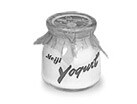
Yogurt in Japan(1)
Yogurt-making started in Japan more than 100 years ago.
You may think that yogurt is a relatively new food that has been introduced to Japan, but apparently a yogurt-like fermented milk was brought to Japan in as early as the Nara period.
Evidently, the first time Japanese ever tasted cow milk was during the era of Emperor Kinmei (reign: 540-571), when cattle were imported to Japan from Baekje.
Shortly thereafter, nationally-managed pasturelands were set up across Japan. As cow milk goes off quickly if left as is, people were already heating it up to turn it into dairy products resembling the condensed milk or yogurt of today, and also processing it to make butter and cheese for consumption over extended periods.
However, those dairy products remained as rare luxuries that only a small portion of the population would enjoy, for many years to come.
The first yogurt products were developed and marketed in Japan during the Meiji period.
Fermented milk products became available for consumption by the general public in Japan halfway through the Meiji era. As Japan opened up to the rest of the world for “civilization and enlightenment” in this period, Japan became inundated with imported foreign cultures, which included dietary habits. As a result, people started drinking cow milk over time.
Circa 1894, one unknown individual came up with the idea of marketing a milk variant to expand sales channels through which milk could be sold in larger quantities, and called it “quasi-milk.” It was actually yogurt, and the marketer promoted the product by claiming it would help regulate intestinal function.
In 1908, yogurt was also introduced to the field of medicine in Japan, when medical researchers took yogurt bacteria imported from France to make yogurt and used it to treat diabetes with good results.
Then, towards the end of the Meiji era, a series of yogurt and other dairy products were commercially released in Japan, and more and more companies joined this fast-growing food market that offered products utilizing lactic acid bacteria. In the early Taisho era, the annual yogurt production in Japan reached 34 tons, and yogurt gradually became part of the diet among Japanese. Indeed, use of the word “yogurt” started in Japan around this time.
Going back a little in time, a milestone event took place in 1908, when an entrepreneur by the name of Kaiun Mishima traveled to Inner Mongolia and tasted Mongolian sour milk. After returning to Japan, Mishima developed a beverage that contained lactic acid bacteria, inspired by his encounter in Mongolia, and started marketing it under the Calpis brand in 1919.
While new food products that used lactic acid bacteria were introduced to Japanese consumers at this time, they did not quite catch on and become staple foods among the general public .
Yogurt production in Japan enters full swing in 1950 in the post-war period.
After World War II ended, Japan entered an extended period of food scarcity, but yogurt gradually started gaining recognition among the people as an excellent health-enhancing food product.
In 1950, Meiji Dairies Corporation (the predecessor of Meiji Co., Ltd.) started full-scale production of yogurt products at its factory. Other dairy product companies also started manufacturing and selling yogurt in this period.
Most of the yogurt products that were produced in Japan at the time contained sweeteners and flavoring agents, and were coagulated using agar or gelatin. This type of yogurt unique to Japan, called “hard yogurt,” was usually sold in small glass bottles (of 90 to 100 ml).
Records from 1953 show that as many as 50,000 bottles of yogurt were consumed in Tokyo alone per day.
Consumption of yogurt in Japan continued to increase from this point on, and the fermented milk product slowly but surely made its way into a growing number of people’s diets in Japan.
In terms of the technology involved in the development and manufacturing of yogurt, the world’s first continuous milk fermentation apparatus was invented in Japan in 1964, and more new technologies were later developed that would allow the production of yogurt products of greatly improved, consistent quality.
In 1969, Meiji and other yogurt companies started selling fruits yogurt (soft yogurt) containing fruit pulp in plastic containers.

- Feature(1) Yogurt advertising copy written by Ryunosuke Akutagawa
- When the famed author Ryunosuke Akutagawa was still a student, he wrote some yogurt advertising copy for his biological father who ran a stock farm and milk shop.

- Feature(2) Factor that ignited the yogurt craze: The Hauser Diet
- In his 1951 book titled "Look Younger; Live Longer," the world-renowned American nutritionist Dr. Gayelord Hauser proposed a health-positive and beauty-enhancing diet that made sense, which included yogurt. In the world of Hollywood movies that was in its golden age at the time, many actresses adopted this Hauser diet, which then became popular in the West and eventually became widespread in Japan too. This yogurt craze has managed to maintain its momentum in Japan to this day.



















